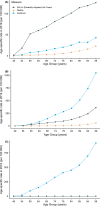Global, regional and national incidence, mortality and disability-adjusted life-years of skin cancers and trend analysis from 1990 to 2019: An analysis of the Global Burden of Disease Study 2019
- PMID: 34105887
- PMCID: PMC8290243
- DOI: 10.1002/cam4.4046
Global, regional and national incidence, mortality and disability-adjusted life-years of skin cancers and trend analysis from 1990 to 2019: An analysis of the Global Burden of Disease Study 2019
Abstract
Background: Information about global and local epidemiology and trends of skin cancers is limited, which increases the difficulty of cutaneous cancer control.
Methods: To estimate the global spatial patterns and temporal trends of skin cancer burden. Based on the GBD 2019, we collected and analyzed numbers and age-standardized rates (ASR) of skin cancer incidence, disability-adjusted life years (DALYs) and mortality (ASIR, ASDR, and ASMR) in 204 countries from 1990 through 2019 were estimated by age, sex, subtype (malignant skin melanoma [MSM], squamous-cell carcinoma [SCC], and basal-cell carcinoma [BCC]), Socio-demographic Index (SDI), region, and country. Temporal trends in ASR were also analyzed using estimated annual percentage change.
Results: Globally, in 2019, there were 4.0 million BCC, 2.4 million SCC, and 0.3 million MSM. There were approximately 62.8 thousand deaths and 1.7 million DALYs due to MSM, and 56.1 thousand deaths and 1.2 million DALYs were attributed to SCC, respectively. The men had higher ASR of skin cancer burden than women. The age-specific rates of global skin cancer burden were higher in the older adults, increasing trends observed from 55 years old. Geographically, the numbers and ASR of skin cancers varied greatly across countries, with the largest burden of ASIR in high SDI regions. However, an unexpected increase was observed in some regions from 1990 to 2019, such as East Asia, and Sub-Saharan Africa. Although there was a slight decrease of the ASMR and ASDR, the global ASIR of MSM dramatically increased, 1990-2019. Also, there was a remarkable increase in ASR of BCC and SCC burden.
Conclusions: Skin cancer remains a major global public health threat. Reducing morbidity and mortality strategies such as primary and secondary prevention should be reconsidered, especially in the most prevalent and unexpected increased regions, especially for those areas with the greatest proportions of their population over age 55.
Keywords: basal-cell carcinoma; disability-adjusted life-years; global burden of disease; incidence; malignant skin melanoma; mortality; skin cancers; squamous-cell carcinoma.
© 2021 The Authors. Cancer Medicine published by John Wiley & Sons Ltd.
Conflict of interest statement
The authors declare to no conflicts of interest that pertain to this work.
Figures




References
-
- Lomas A, Leonardi‐Bee J, Bath‐Hextall F. A systematic review of worldwide incidence of nonmelanoma skin cancer. Br J Dermatol. 2012;166(5):1069‐1080. - PubMed
-
- Gordon R. Skin cancer: an overview of epidemiology and risk factors. Semin Oncol Nurs. 2013;29(3):160‐169. - PubMed
-
- Cameron MC, Lee E, Hibler BP, et al. Basal cell carcinoma: epidemiology; pathophysiology; clinical and histological subtypes; and disease associations. J Am Acad Dermatol. 2019;80(2):303‐317. - PubMed
-
- Fitzmaurice C, Abate D, Abbasi N, et al. Global, regional, and national cancer incidence, mortality, years of life lost, years lived with disability, and disability‐adjusted life‐years for 29 cancer groups, 1990 to 2017: a systematic analysis for the global burden of disease study. JAMA Oncol. 2019;5(12):1749–1768. - PMC - PubMed
MeSH terms
Grants and funding
LinkOut - more resources
Full Text Sources
Medical
Research Materials

